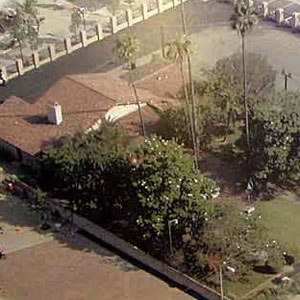Modern Period
(1869 – Present)

- John C. Fremont identifies the exact location of the treaty signing, known then as Casa de Cahuenga, when he revisits the site in 1889.
- By 1900, barely a trace of the Casa was visible. The land had been cultivated with cherry, peach, apricot, walnut and plum trees.
- The location of Spanish version of the Treaty was lost for 77 years, since the signing in 1847. Through considerable research, historian Mrs. A.S.C. Forbes found this version in the private papers of Don Jose Antonio Carrillo in her efforts to authenticate the site and have it recognized by California and the nation.
- The first public recognition of the site took place in 1910. One of the early Mission Bells designed by Mrs. A.S.C. Forbes marking the site as a way station on El Camino Real was placed here by Mrs. Forbes and the Woman’s Club of Hollywood. It was dedicated by Elizabeth Benton Fremont, daughter of Jessie and John C. Fremont. This bell now stands near the Campo gate.
- California History and Landmarks Club was founded by Mrs. Forbes in 1916, partially in response to finding the Campo site undeveloped and neglected. The Club’s goal was to create public interest and support for the state’s historic sites.
- In 1917 a bill was passed by the state legislature to purchase 4 city lots and an adjacent 2.5 acres for a State Park at the site. The legislation was vetoed by the governor, ostensibly due to lack of adequate evidence of the site’s authenticity.
- The site is not officially recognized by the State of California until 1922.
- Site was purchased by the City of Los Angeles on May 23, 1923 for $15,000. At the time a pet hospital with small pueblo revival buildings surrounded by a walled compound had been erected on the site.
- The new Fremont-Pico Memorial Park and Museum was dedicated in October 1924. Formal gardens were laid out. The site was administered by the Los Angeles Parks Commission (later Dept. of Parks and Recreation). The Animal Hospital buildings were refurbished for use as a museum and artifacts gathered for display. Reenactment of the treaty signing, fiestas and community events took place through the 1940s.
- In 1931, an amateur archaeological excavation uncovered the remains of the original Casa de Cahuenga adobe structure.
- By the 1940s, the Memorial Park had fallen into disrepair. The San Fernando Historical Society was formed in 1943 to resurrect the site, sponsoring a Centennial Celebration of the capitulation on January 13, 1947.
- The Centennial became the impetus for the organization of the new Campo de Cahuenga Memorial Association, led by Mrs. A.S.C. Forbes, now nearing 90 years of age, and William A. Allen. In 1949, plans were announced to build a new historical building replicating the original Casa de Cahuenga adobe building as it might have looked. The new building and grounds were dedicated Nov. 2, 1950.
- On Nov. 13, 1964, the Campo de Cahuenga became City of Los Angeles Cultural-Historic Monument No. 29. The Campo is State Landmark #151.
- Beginning in 1995, professional excavations for the Metro Rail subway project encountered a mission-period foundation with a footprint far larger than originally imagined as the Casa de Cahuenga. As the foundation discovery continued to grow, beneath Lankershim Boulevard, so did the archaeology. An adobe measuring 40 x 100 feet was discovered, causing historians to re-think earlier theories about the site’s origins and purpose.
- The excavation site was covered and sealed, and an interpretive excavation site of the foundation, using adobe bricks, was built atop the discovery in early 2000.
- In 2003, the Campo de Cahuenga was enrolled in the National Register of Historic Places.
- In 2007 NBCUniversal Studios announced imminent expansion plans on property surrounding the Campo de Cahuenga. The Campo anticipates significant changes in the near future as this MTA-owned real estate is developed to meet the growing needs of the entertainment industry.